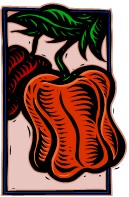 Summer Garden Tips - April 3, 2013 Jeff Schalau, Agent, Agriculture & Natural Resources University of Arizona Cooperative Extension, Yavapai County Here are some gardening tips from Terry Mikel, retired Cooperative Extension Agent, friend, and colleague. These tips were gleaned from his 30 years of horticultural experience. Before planting, remember to amend soil with compost containing some nitrogen, phosphorus fertilizer, and soil sulfur. Below are some of Terry's gardening tips for a few selected crops. Asparagus University of California varieties (i.e. ‘UC 157’) are best adapted to our alkaline soils. Plant seeds or crowns in bottom of an amended, one-foot deep hole and backfill as they grow through the first growing season. Only harvest spears when they are the diameter of your thumb (2nd year) and stop harvesting when they reach the size of a pencil. After harvest is done, fertilize and allow the unharvested spears to grow for the remainder of the growing season. Apply nitrogen fertilizer each year. Green Beans Pole beans are more work than bush beans, but they taste much better. ‘Kentucky Wonder’ is Terry's favorite variety of pole bean. If you must plant bush beans, ‘Contender’ is Terry's pick. Plant bean seeds only after soils reach 70 degrees F. Carrots Rather than planting in rows, broadcast a mixture of your favorite carrot varieties in a prepared bed and thin to 3-4 inches apart. When harvested, each carrot will be a surprise. You can also mix radish seed into the carrot seed mix. By the time radishes are finished, the carrots should be coming on. Cucumbers Bitter skin is caused by any stress on the plant. With cucumbers, it is important not to let the soil dry out. Irrigate regularly and mulch to retain soil moisture. Terry likes the Japanese climbing varieties. Plant cucumbers on a wire fence and encourage them to climb. This saves space in the garden and makes harvest easier. Eggplant Eggplant is very heat tolerant. Large, European varieties (i.e. ‘Black Beauty’) can have bitter skin. These should only be harvested when black and glossy. Japanese varieties (i.e. ‘Ichiban’) do not get bitter skin. Melons Many varieties are out there, so don't both growing plain old cantaloupe. These heavy skinned melons were developed to withstand abuse of commercial processing. Try some uncommon, exotic melon varieties. Whichever you choose, roll the vines. This is done by picking up the vine and placing it back down across the crown of the plant after 2-3 fruit have been set on that vine. We are not sure how it works, but farmers have done it for years. Peanuts Every gardener needs to grow peanuts at least once. Buy raw peanuts from a health food store (they must have an intact integument: thin, papery seed coat). The plant will grow, get yellow flowers, and after the flowers mature, the peg grows from the flower downward to the soil. The peg penetrates the soil surface and a peanut is formed. Harvest after the plant is killed by frost. You can dry and roast the peanuts in the oven. Peppers Sweet (bell type) and chile peppers are well suited to our area. Do not plant outdoors until night temperatures rise above 55 degrees F unless using frost protection. ‘Sandia’ and ‘Big Jim’ are excellent green chiles. Three or four jalapeno or serrano plants will produce enough to make lots of salsa. Bell peppers need to have enough foliage to shade fruit and prevent sunburn. Potatoes There are 100's of potato varieties to try. Buy certified seed potatoes and plant in early spring. Plant deep and backfill as the plants grow. If harvested during the bloom, you get new potatoes. Otherwise, dig mature potatoes after vines die back in August or September. Tomatoes Again, there are 100's of varieties. The main challenge we have is heat. Tomatoes do not fruit well when temperatures rise above 90 degrees F. Most years, the Verde Valley is hit by curly top virus (CTV). It is made worse by cool season weeds, especially London rocket. The beet leafhopper is the vector of CTV. Once the weeds die, beet leafhoppers migrate to cooler areas and encounter other host plants. They inadvertently sample tomatoes, peppers, squash, and cucumbers transmitting the virus to the crop plant. Most growers cover tomato plants with floating row cover to reduce exposure to leaf hoppers and/or keep several transplants in reserve to replace CTV infected plants. Follow the Backyard Gardener on Twitter – use the link on the BYG website. If you have other gardening questions, call the Master Gardener help line in the Camp Verde office at 928-554-8999 Ext. 3 or e-mail us at cottonwoodmg@yahoo.com and be sure to include your name, address and phone number. Find past Backyard Gardener columns or provide feedback at the Backyard Gardener web site: http://cals.arizona.edu/yavapai/anr/hort/byg/. |